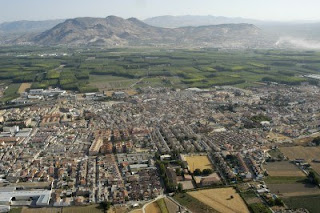In the fifteenth century, Spanish urbanism
experienced a dramatic transformation due to the Catholic monarch take-over of
the Islamic Emirate of Granada. This event marks the completion of the Reconquista (a century long conquering
of the Iberian Peninsula by the Christian kingdoms from the Islamic kingdoms in
the Middle Ages) and its effects on the architecture and urban planning of the
Iberian city. The dramatic design changes seen in the old city of Granada can
be contrasted with Santa Fe de Granada, which was constructed as an encampment
set up by the Catholic monarch after the Spanish conquest of Granada.
Aerial View of Santa Fe, in the Province of Granada. http://www.123rf.com/photo_9762353_aerial-view-of-santa-fe-in-the-province-of-granada.html.
By analyzing Granada and Santa Fe de Granada (Fe
refers to the Catholic faith), it was evident that the layout of Santa Fe follows a grid plan centered around two main
roads that intersect at the centre plaza. In contrast, Granada follows an
organic layout, which reflects their disarray and inevitable destruction. Since
Santa Fe was constructed as an army base for the Spaniards, it would probably
function like the Wari military centre of Pikillacta, now in modern Peru. The
grid system represents order and stability for the military base. As well, by
having a grid system, it makes the control of the movement of citizens throughout
the area
The architecture within these two locations also
differs a lot. In Granada, with the growing involvement of the Catholic faith,
many of the Islamic mosques were converted to Christian churches or completely
torn down. This transformed the urban landscape in Granada due to all the
cathedrals being put up. The architecture in Santa Fe served as a place for the
Spanish Catholic monarch; therefore its landscape consists of many churches and
monuments. The design elements within Santa Fe also reflect Renaissance style.
Similar to the Spanish conquest of Tenochtitlan in
Mexico, the Spaniards continued their tradition of destructing and
re-constructing the overthrown area of Granada with the creation of Santa Fe de
Granada. This was done to symbolize the clearing out of old religions, beliefs,
and traditions in order for their own Catholic traditions to be incorporated
into society.
Works Cited

No comments:
Post a Comment